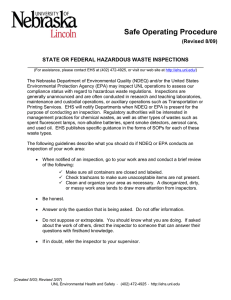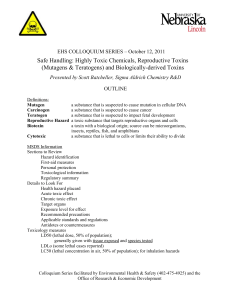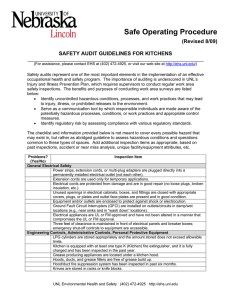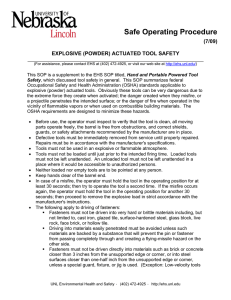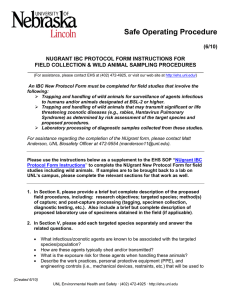In this issue of the Environmental Health and Safety (EHS)... 1. Did you know? 2. Laboratory Safety Colloquium
advertisement
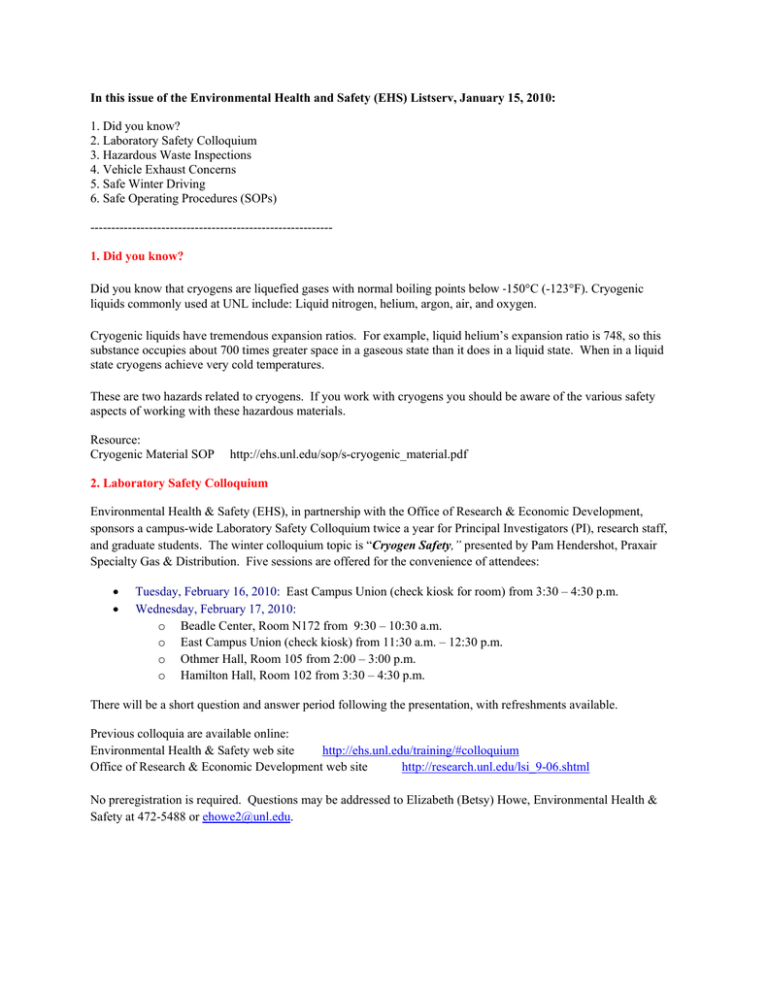
In this issue of the Environmental Health and Safety (EHS) Listserv, January 15, 2010: 1. Did you know? 2. Laboratory Safety Colloquium 3. Hazardous Waste Inspections 4. Vehicle Exhaust Concerns 5. Safe Winter Driving 6. Safe Operating Procedures (SOPs) ---------------------------------------------------------1. Did you know? Did you know that cryogens are liquefied gases with normal boiling points below ‐150°C (-123°F). Cryogenic liquids commonly used at UNL include: Liquid nitrogen, helium, argon, air, and oxygen. Cryogenic liquids have tremendous expansion ratios. For example, liquid helium’s expansion ratio is 748, so this substance occupies about 700 times greater space in a gaseous state than it does in a liquid state. When in a liquid state cryogens achieve very cold temperatures. These are two hazards related to cryogens. If you work with cryogens you should be aware of the various safety aspects of working with these hazardous materials. Resource: Cryogenic Material SOP http://ehs.unl.edu/sop/s-cryogenic_material.pdf 2. Laboratory Safety Colloquium Environmental Health & Safety (EHS), in partnership with the Office of Research & Economic Development, sponsors a campus-wide Laboratory Safety Colloquium twice a year for Principal Investigators (PI), research staff, and graduate students. The winter colloquium topic is “Cryogen Safety,” presented by Pam Hendershot, Praxair Specialty Gas & Distribution. Five sessions are offered for the convenience of attendees: Tuesday, February 16, 2010: East Campus Union (check kiosk for room) from 3:30 – 4:30 p.m. Wednesday, February 17, 2010: o Beadle Center, Room N172 from 9:30 – 10:30 a.m. o East Campus Union (check kiosk) from 11:30 a.m. – 12:30 p.m. o Othmer Hall, Room 105 from 2:00 – 3:00 p.m. o Hamilton Hall, Room 102 from 3:30 – 4:30 p.m. There will be a short question and answer period following the presentation, with refreshments available. Previous colloquia are available online: Environmental Health & Safety web site http://ehs.unl.edu/training/#colloquium Office of Research & Economic Development web site http://research.unl.edu/lsi_9-06.shtml No preregistration is required. Questions may be addressed to Elizabeth (Betsy) Howe, Environmental Health & Safety at 472-5488 or ehowe2@unl.edu. 3. Hazardous Waste Inspections UNL is subject to unannounced inspections by the Environmental Protection Agency (EPA) and/or Nebraska Department of Environmental Quality (NDEQ), to assess compliance with waste management regulations. These inspections typically occur every 2-3 years. We anticipate an inspection sometime during the next several months. As a reminder, if you are the subject of such an inspection: Review your work area. Make sure that all containers are closed, properly labeled, in good condition, and located in the same area where the waste was generated. If an inspector visits your work location, answer their questions honestly, but answer only the question asked. There is no need to volunteer information. After you have answered the inspector's question, wait silently and patiently for their next question. Avoid the temptation to keep talking because silence is uncomfortable. If you don’t know the answer to a question - don’t guess just say that you don’t know. You may be asked to direct them to your supervisor or someone else who may know the answer. For more guidance, refer to: State or Federal Hazardous Waste Inspections SOP http://ehs.unl.edu/sop/s-state_fed_inspections.pdf 4. Vehicle Exhaust Concerns A number of employees at UNL drive as part of their job duties. With the colder weather, EHS has received a greater number of indoor air quality concerns related to vehicle exhaust entering into buildings. This is especially problematic when the vehicles idle in close proximity to building air supply or entry/exit doors. A simple solution is to avoid idling vehicles near buildings. In addition, idling vehicles is contrary to University fuel conservation policies. 5. Safe Winter Driving Winter driving poses special hazards. Here are some tips for safe winter driving: Make sure your vehicle is in good working order: tune up the car; check the battery, antifreeze and windshield fluid; fix any leaks. Know your car. This is especially important if you use a University vehicle intermittently. Before you drive, make sure you know how to work the lights, heater, wipers, defrost and other key features. Clean off the vehicle entirely. Visibility is even more important while driving in inclement weather. Clear all windows, side mirrors, headlights and taillights. Clear off the vehicle roof, as that snow is likely to slide onto windows as you drive. Driving in snow, sleet, and ice is very treacherous, so do everything slowly and gently—accelerate, turn, brake. Anticipate turns and stops. Leave plenty of space between your vehicle and other vehicles. Everyone else may not be driving as cautiously as you are. Keep your gas tank at least half full to avoid gas line freeze-up. Always wear your seat belt. Concentrate on driving only, do not talk or text on cell phones, even hands-free. Avoid distractions from others in the vehicle, radio, or CDs. When operating a motor vehicle, your focus should be DRIVING. 6. Safe Operating Procedures (SOPs) SOPs on a wide variety of safety topics are available through the EHS website at http://ehs.unl.edu/sop/. Remember...SAFETY IS AN ATTITUDE!
